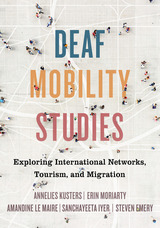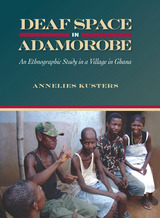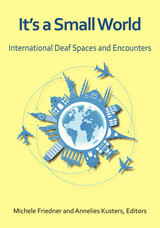3 books by Kusters, Annelies

Deaf Mobility Studies
Exploring International Networks, Tourism, and Migration
Annelies Kusters
Gallaudet University Press, 2024
Deaf Mobility Studies revolutionizes how we think about deaf people’s international experiences. Equipped with a common theoretical framework, a team of five deaf ethnographers journeyed alongside their participants to delve into a rich array of experiences—ranging from career advancements and marriages to tourism and the challenges faced by deaf refugees. The authors present their findings within the framework of Deaf Mobility Studies, which brings together the transdisciplinary fields of Deaf Studies and Mobility Studies. Far from taking 'deaf cosmopolitanism' as a given, this work scrutinizes it as a multifaceted phenomenon to be both affirmed and questioned. Themes that emerge include how deaf people seek spaces of belonging, engage in languaging, expand their networks, and experience immobility.
The text is augmented by direct links to clips in nine ethnographic films, analysis of selected film excerpts and screenshots, and compelling data visualizations. Deaf Mobility Studies is an expansive odyssey through the complexities and opportunities inherent in deaf international mobility.
The text is augmented by direct links to clips in nine ethnographic films, analysis of selected film excerpts and screenshots, and compelling data visualizations. Deaf Mobility Studies is an expansive odyssey through the complexities and opportunities inherent in deaf international mobility.
[more]

Deaf Space in Adamorobe
An Ethnographic Study in a Village in Ghana
Annelies Kusters
Gallaudet University Press, 2015
Shared signing communities consist of a relatively high number of hereditarily deaf people living together with hearing people in relative isolation. In the United States, Martha’s Vineyard gained mythical fame as a paradise for deaf people where everyone signed up until the 19th century. That community disappeared when deaf people left the island, newcomers moved in, married locals, and changed the gene pool. These unique communities still exist, however, one being the Akan village in Ghana called Adamorobe. Annelies Kusters, a deaf anthropologist, traveled to Adamorobe to conduct an ethnographic study of how deaf and hearing people live together in the village. In her new book, Kusters reveals how deaf people in Adamorobe did not live in a social paradise and how they created “deaf spaces” by seeking each other out.
Deaf Space in Adamorobe reveals one example of the considerable variation in shared signing communities regarding rates of sign language proficiency and use, deaf people’s marriage rates, deaf people’s participation in village economies and politics, and the role of deaf education. Kusters describes spaces produced by both deaf and hearing people as a cohesive community where living together is an integral fact of their sociocultural environments. At the same time, Kusters identifies tension points between deaf and hearing perspectives and also between outside perspectives and discourses that originated within the community. Because of these differences and the relatively high number of deaf people in the community, Kusters concludes it is natural that they form deaf spaces within the shared space of the village community.
Deaf Space in Adamorobe reveals one example of the considerable variation in shared signing communities regarding rates of sign language proficiency and use, deaf people’s marriage rates, deaf people’s participation in village economies and politics, and the role of deaf education. Kusters describes spaces produced by both deaf and hearing people as a cohesive community where living together is an integral fact of their sociocultural environments. At the same time, Kusters identifies tension points between deaf and hearing perspectives and also between outside perspectives and discourses that originated within the community. Because of these differences and the relatively high number of deaf people in the community, Kusters concludes it is natural that they form deaf spaces within the shared space of the village community.
[more]

It's a Small World
International Deaf Spaces and Encounters
Michele Friedner
Gallaudet University Press, 2015
It’s a Small World explores the fascinating and, at times, controversial concept of DEAF-SAME (“I am deaf, you are deaf, and so we are the same”) and its influence on deaf spaces locally and globally. The editors and contributors focus on national and international encounters (e.g., conferences, sporting events, arts festivals, camps) and the role of political/economic power structures on deaf lives and the creation of deaf worlds. They also consider important questions about how deaf people negotiate DEAF-SAME and deaf difference, with particular attention to relations between deaf people in the global South (countries in Africa, Asia, and Latin America, with access to fewer resources than other countries) and the global North (countries in Europe, along with Canada, the US, Australia, and several other nations with access to and often control of resources).
Editors Michele Friedner and Annelies Kusters and their contributors represent a variety of academic and professional fields, from anthropology and linguistics to cultural and religious studies. Each chapter in this original volume highlights a new perspective on the multiple intersections that occur between nationalities, cultures, languages, religions, races, genders, and identities. The text is organized into five sections—Gatherings, Language, Projects, Networks, and Visions. Taken all together, the 23 chapters in this book provide an understanding of how sameness and difference are powerful yet contested categories in deaf worlds.
[more]
READERS
Browse our collection.
PUBLISHERS
See BiblioVault's publisher services.
STUDENT SERVICES
Files for college accessibility offices.
UChicago Accessibility Resources
home | accessibility | search | about | contact us
BiblioVault ® 2001 - 2024
The University of Chicago Press









